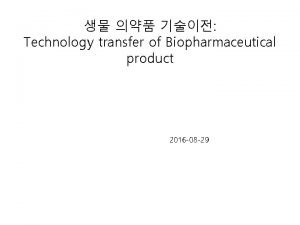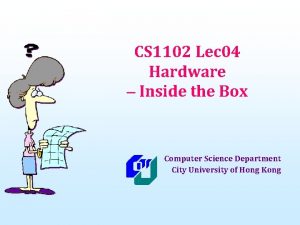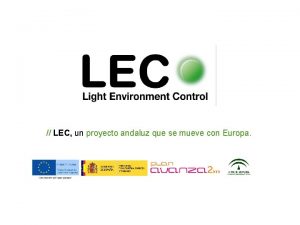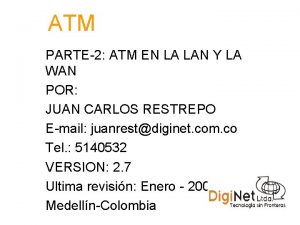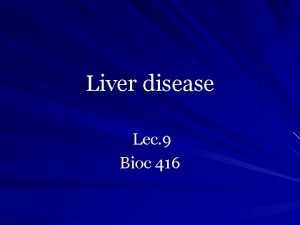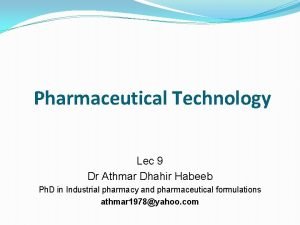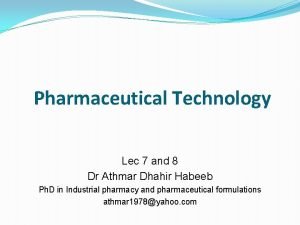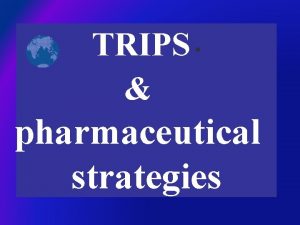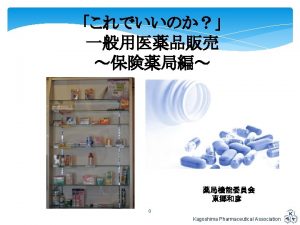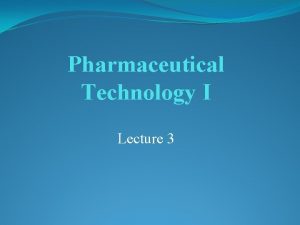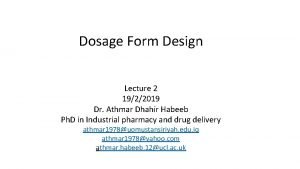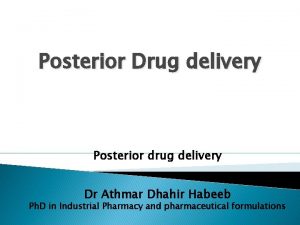Pharmaceutical Technology Lec 3 08102017 Dr Athmar Dhahir











- Slides: 11

Pharmaceutical Technology Lec 3 08/10/2017 Dr Athmar Dhahir Habeeb Ph. D in Industrial pharmacy and pharmaceutical formulations

Effect of other substances on solubility � The solubility of substance depends on the type and concentration of other substance in the solution. � The solubility of slightly soluble electrolytes is reduced by addition of second salt which contain a common ion Ag. Cl Ag + Cl Na. Cl Na + Cl � The common ion may form complex with slightly soluble electrolyte may lead to increase the solubility of salts e. g. Mercuric iodide is insoluble in water yet it dissolved by solution of soluble iodides. � Note: Most volatile oils such as peppermint, rose and citrus oils are only very slightly soluble in water but they may be solubilized by the use of certain nonionic surfactant.

Expression of solubility: �The solubility of substance may expressed in various ways but usually it is designated as the number of m. L of solvent required to dissolve 1 g of solute or 1 m. L of substance that are liquids at 25 o. C. �If the solubility of substance has been determined accurately it may be used as an index of purity for that substance.

Relative terms of solubility �The solubility of a substance in a given solvent may be determined by preparing a saturated solution of it at a specific temperature and by determining by chemical analysis the amount of chemical dissolved in a given weight of solution. �When the exact solubility has not been determined, general expressions of relative solubility may be used

• These terms are defined in the USP and presented in the following table

Solvents for pharmaceutical use: The choice of suitable solvent for pharmaceutical use depends on: �Toxicity: Not toxic mean there is no harmful effect on body. �Volatility: In case of volatility, it evaporates and lead to precipitate the active ingredient and it may become toxic or harmful. Therefore, it should store in cool place and in a well closed container. �Stability: In case of stability, it should not interact with active ingredient or the added substances and should be stable on storage condition and protect the active ingredient stable.

�Water: Good solvent for many inorganic salts and many organic compound . Its miscibility with other solvents such as alcohol and glycerin make it useful vehicle for many pharmaceutical preparation. �Alcohol: Ethyl alcohol, ethanol, (94. 9 -96 % by volume C 2 H 5 OH). It is good solvent for many organic substances both natural and synthetic. �It dissolves important plant constituents such as resins, volatile oil, alkaloids, and glycosides and it is also used in liquid product as antimicrobial preservatives alone or as a co-preservative with other preservatives like parabens. � Alcohol produce solution has greater stability than their aqueous counter parts.

�Hydroalcoholic liquids are commonly used as solvents for plant constituents because they effectively dissolve the active principles. They don’t dissolve therapeutically inert plant material like gums and starches. �Alcohol is frequently used with other solvents, as glycols and glycerin to reduce the amount of alcohol required. so the recommended alcohol content limit is as follows: 1. For OTC oral products intended for children under 6 years of age, the recommended alcohol limit is 0. 5% 2. For product intended for children 6 to 12 years of age the recommended limit is 5% 3. For products recommended for children over 12 year and for adults, the recommended limit is 10%.

�Diluted Alcohol: NF 49 -50%: is prepared by mixing equal volume of alcohol and water used in manufacture of certain preparation. �Dehydrated alcohol: 99. 5% by volume C 2 H 5 OH (absolute alcohol). It is practically free from water so it has greater range of solvent power. �Isopropyl alcohol: Used in cosmetic and dermatologic formulation.

Glycerin: is a clear syrupy liquid with a sweet taste. It is miscible with both water and alcohol. �As a solvent, it is comparable with alcohol, but because of its viscosity, solutes are slowly soluble in it unless it is rendered less viscous by heating. �Glycerin has preservative qualities and is often used as a stabilizer and as an auxiliary solvent in conjunction with water or alcohol. �It is used in many internal preparations. It is excellent solvent for tannins, phenol and boric acid.

�Propylene glycol: viscous liquid, miscible with water and alcohol. It is a useful solvent with a wide range of applications and is frequently substituted for glycerin in modern pharmaceutical formulations. �Polyethylene Glycol 400: It is miscible with water, acetone and alcohol. It dissolve many water soluble organic compounds and contain water insoluble substance e. g. Acetyl salicylic acid, theophylline. �Chloroform: It is miscible with alcohol, ether; benzene, solvent hexane, fixed and volatile oil . It dissolve in 210 volume of water. It is not flammable but its vapor is harmful and toxic.

